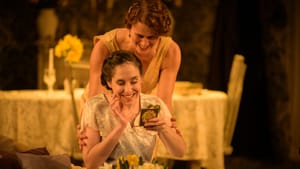Stay in the Loop
BSR publishes on a weekly schedule, with an email newsletter every Wednesday and Thursday morning. There’s no paywall, and subscribing is always free.
Broken glass
Arden Theatre Company presents Tennessee Willliams’s The Glass Menagerie

“If you breathe, it breaks,” implores Laura Wingfield, the wistful young woman who tends her collection of crystal figurines with the utmost care in The Glass Menagerie. The play itself—a breakthrough for playwright Tennessee Williams when it first appeared on Broadway in 1945—is equally delicate, especially in the wrong hands. Arden Theatre Company’s season-opening production feels like the proverbial bull loose in the china shop.
Director Terrence J. Nolen’s interpretation falls flat due to misunderstanding. Williams, who based aspects of the drama on his own early life in St. Louis, where he lived with his grandiose mother and beloved sister Rose, structured the story as a doleful memory play. The narrator and authorial stand-in, Tom Wingfield (Sean Lally), looks back on his past from a removed distance, with a healthy dose of unreliability.
Poetry and prose
Williams operates in poetry. Tom soldiers through his dreadful days working at a shoe factory by dreaming of a more rewarding life as a writer. His mother Amanda (Krista Apple), an exile from the Old South, comforts herself with remembrances of a more genteel past. And Laura (Hannah Brannau), who lives with the “slight defect” of a crooked leg, slips further into a fantasy world of glass animals and Victrola records. The script is peppered with blossoming language and deep wellsprings of metaphor.
Nolen, on the other hand, directs in prose. Williams’s reverie—described in Tom’s opening monologue as “dimly lighted, sentimental, not realistic”—becomes a kitchen-sink drama, entirely devoid of the deceptive symbolism that masks the dire situation of the Wingfield family’s poverty and predestined destruction. The audience waits through the preparations for the pivotal appearance of the Gentleman Caller (an ineffective Frank Jimenez) who represents the clan’s last hope for survival with the grim knowledge that it is a fool’s errand.
Projections and pragmatism
This reading influences the acting in negative ways. Lally seems determined to convince the audience that he’s inventing each line of dialogue in the moment—a choice that makes no sense in a play purposely constructed around a frame narrative. He employs a flat affect throughout, with no trace of Southern-ness and no sense of a poet’s gift for words. An actor playing Tom shouldn’t try to imitate Tennessee Williams, but he should project the playwright’s conflicted relationship to his personal history. Lally comes across as a disinterested interlocutor.
Apple’s tightly controlled performance loosens in the play’s final moments, when it becomes unavoidable that Amanda’s last-ditch dreams for Laura’s future will come to nothing. But without the dramatic build-up to that scene, and a sense that Amanda believes wholeheartedly in the scheme to marry her daughter off, the result is anticlimactic. Apple is too pragmatic to convince the audience that Amanda has pulled the wool over her own eyes.
Brannau brings a sweet, sad quality to Laura that is pleasant but lingers on one note. Too often in productions of this play, Laura can feel like a projection of Tom and Amanda’s perceptions of her. I long for an actor to bring something wry and ironic to the role, to suggest that her still waters really do run deep, as Amanda suggests in an early scene.
Just like all the others
Although Thom Weaver’s lighting generally hits the right speculative notes, his scenic design—a light and airy flat, furnished with elegant floating set pieces—lacks the requisite feeling of a stifling tenement, with the family constantly on top of each other. As was the case in the Arden’s production of A Streetcar Named Desire early this year, the F. Otto Haas stage is simply too wide and deep to convey the cramped living conditions that turn a Williams play into a powder keg. Olivera Gajic’s costumes often look like a contemporary person’s idea of period clothing, and they sometimes don’t make dramaturgical sense: why is the cotillion dress Amanda wears in the second act festooned with flowers, when she says in her monologue that she “had to take them all off”?
Near the end of the play, Laura’s favorite glass animal—the distinctive, individual unicorn—is destroyed when his horn is broken. Attempting to put a positive spin on the disaster, she remarks that now he’s just like all the other horses. But there is melancholy beneath this sentiment. Unfortunately, in this uninspired production, a treasure of great American drama feels as common as any other play.
What, When, Where
The Glass Menagerie. By Tennessee Williams, directed by Terrence J. Nolen. $28-$58. Through November 6, 2022, at the Arden Theatre, 40 North 2nd Street, Philadelphia. (215) 922-1122 or ardentheatre.org.
Masks are not required in the theater.
Accessibility
The Arden is a wheelchair-accessible venue. Assistive listening devices are available at all performances. To purchase accessible seating in advance, call (215) 922-1122 or email [email protected].
Sign up for our newsletter
All of the week's new articles, all in one place. Sign up for the free weekly BSR newsletters, and don't miss a conversation.

 Cameron Kelsall
Cameron Kelsall